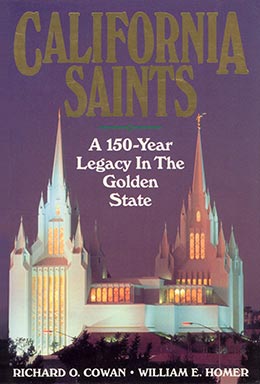Apostles amid Gold Seekers: 1849
Richard O. Cowan and William E. Homer, California Saints: A 150-Year Legacy in the Golden State (Provo, UT: Religious Studies Center, Brigham Young University, 1996), 127–42.
The once-rare sight of a ship sailing with emigrants from New York City was now a daily occurrence. During the first two months after President Polk’s address confirming the gold discovery, at least 178 vessels sailed from the eastern seaboard to California. Before the year ended, eighty-nine thousand people flocked to California seeking gold: fortytwo thousand overland, forty-one thousand by sea, and six thousand from Mexico. [1]
Initially, Brigham Young continued to discourage the Saints from going to California. As the year wore on, however, he temporarily softened his stance in an attempt to broaden the Latter-day Saints’ political influence in California and to enhance the flow of gold through Salt Lake City.
The 1848–49 winter in the Great Basin was again harsh. Many there learned of the California wagon train that had come to Utah the previous fall laden with gold. There were those, including the contingent of southern Saints that Brannan was originally to have escorted to California, who still wanted to leave Utah. In addition to the lure of gold, they were also unaccustomed to harsh winters. Open questioning of President Young’s leadership and wisdom was occasionally heard as some wondered aloud whether they would have been better off if they had gone with Brannan.
On 24 February 1849, Robert Crow presented a petition on behalf of himself and others that they be allowed to go to California under official Church sanction. Crow’s petition was denied. On Sunday, 29 February, Brigham Young confronted this issue in a discourse to a large audience in the bowery of Salt Lake’s Old Fort:
The time has not come for the Saints to dig gold. It is our duty first to develop the agricultural resources of the country. . . . The worst fear that I have about this people is that they will get rich, . . . forget God, . . . wax fat, and kick themselves out of the Church and go to hell. This people will stand mobbing, robbing, poverty, and all manner of persecution, and be true. But my greater fear for them is that they cannot stand wealth. [2]
One biographer regarded this speech as a high point of Brigham Young’s leadership career. Even though “his audience stood before him in the snow, poorly clad, shivering in the cold weather,” he convinced them that they were better off working in Utah’s harsh climate than they would be in wealth and comfort in California. [3]
In similar circumstances, Heber C. Kimball, one of President Young’s two counselors, prophesied with startling discernment: “It will be but a little while, brethren, before you shall have food and raiment in abundance, and shall buy it cheaper than it can be bought in the cities of the United States.” President Kimball himself wondered how this could be. He later admitted that “the Lord led me right, but I did not know it.” [4]
Gold seekers, when traveling through Utah, ensured the fulfillment of this prophecy. Many wintered among the Saints in the Rockies, paying for lodging and supplies. Others, trying to quicken their pace and beat those in front of them to the gold, abandoned goods along the way to lighten their loads. Almost all of them paid Latter-day Saint ferrying companies to take them across the various rivers. Blacksmithing also became highly profitable. “Thus,” as one Latter-day Saint acknowledged, “in a few years in this desolated part of the mountains we were beginning to enjoy to some degree that which might have taken years had not the Lord provided for the poor saints by His providence in opening up the gold mines in California and inspiring the Gentiles with a lust for gold.” [5]
One of those “Gentiles” traveling to California was a young German emigrant. In the central Utah town of Fillmore he met an attractive young lady. “He was so attracted to her that he later panned just enough gold to pay for a wedding ring and then hastened back to marry her and later join the Church!” Their great-grandson, James E. Faust, would later become an apostle and then a counselor in the First Presidency in 1995. [6] The Church Directs Attention to California For the previous two or three seasons, the Church had devoted its resources to getting the large body of refugees safely across the Plains and settled in the mountains. Though the Saints in California had needed the Church’s help for some time, they had been too few and far away to be a priority to Church leaders. Over three years had passed since an apostle, Elder Orson Pratt, had been with the Brooklyn Saints in New York City. However, now that the Church was settled in the Salt Lake Valley, leaders were able to give the members in California more attention. As the April 1849 general conference drew near, they gave further thought to the assignment given to Elder Amasa M. Lyman the previous fall. They determined to send Elder Lyman and Porter Rockwell to “look after the interest of the Church and the Saints, and to return with those who might be coming to the valley in the fall.” [7] On 8 April, as part of the conference, Elder Lyman was blessed and set apart for his mission.
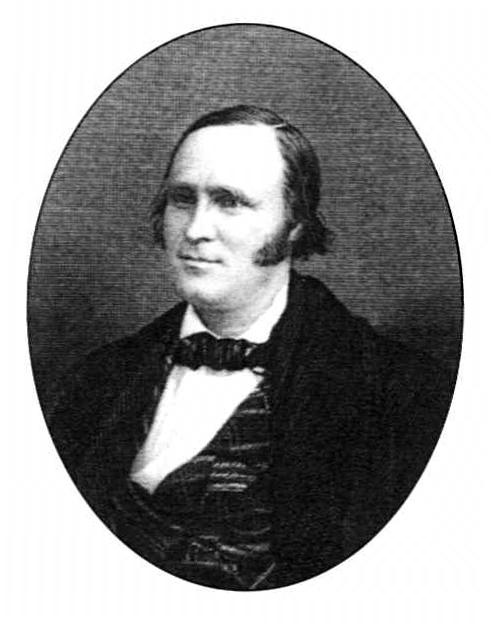 Amasa M. Lyman
Amasa M. Lyman
While Elder Lyman made final preparations for his departure, another apostle, Charles C. Rich, who had been called to the Quorum of the Twelve only a few weeks earlier, received a similar assignment to California. On the same day Elder Lyman was set apart, Elder Rich was “appointed to go and establish a settlement or stake on or near the Bay of San Francisco.” Church leaders instructed him to “gather the Saints, preach the gospel, and preside over the affairs of the Church on the Western Coast.” [8] His departure date was postponed until the fall, however, “it not being considered safe . . . while the route west was so full of emigrants.” [9]
One of the letters Elder Lyman carried to California was written by Brigham Young to Samuel Brannan on 5 April. It was a response to Brannan’s report of complaints among the Saints. President Young responded that the man “who is always doing right has no occasion to fear any complaints.” He further said that he expected a hundred thousand dollars in tithing if Brannan had, according to reports, accumulated a million dollars to tithe. President Young cautioned:
If you want to continue to prosper, do not forget the Lord’s treasury, lest he forget you. . . . And when you have settled with the treasury, I want you to remember that Brother Brigham has long been destitute. . . . He wants you to send him a present of twenty thousand dollars in gold dust. . . but a trifle when gold is so plentiful. . . . My council will not be equal with me unless you send $20,000 more to be divided between Brothers Kimball and Richards, who like myself are straitened. A hint to the wise is sufficient. So when this is accomplished, you will have our united blessing. . . . But should you withhold, when the Lord says give, your hopes and pleasing prospects will be blasted in an hour you think not of and no arm to save. . . . But I am persuaded better things of Brother Brannan. I expect all I have asked when Brother Lyman returns. [10]
It is impossible to determine the exact intent of this unusual entreaty, but it should be considered in light of the fact that Church leaders devoted their adult lives to unpaid Church service, and there was therefore no clear distinction between private and ecclesiastical property. While the Church in Utah was in poverty and Brannan was wealthy, he was being asked to devote some of his great wealth to support the leaders of the Church. [11] It may also have been a test of Brannan’s loyalty to the Church and its leaders or a test of his willingness to share with those in Utah the prosperity which his position and the common labors of the Saints in California had won.
Amasa Lyman and Porter Rockwell
Amasa Lyman’s party of twenty men left for California on 12 April. Even though President Young was adamant that he would “not fellowship” those going to California without authorization, Robert Crow’s family and several other unconvinced southern Saints likely went with Elder Lyman. [12] Elder Lyman later remembered how “that singular epidemic raged to a wonderful extent, known as gold fever. It resulted in carrying off some eighty families, besides [Elder Lyman’s] party of twenty men.” [13] Despite Brigham Young’s caution, many of those enticed were stalwart Church members. Half the “Captains of Ten” from the 1847 Utah Pioneers eventually ended up in California. [14]
Elder Lyman’s party took the northern route via the California Trail. Traveling by horseback, they made good time across the desert but found the deep snow in the Sierra Nevada mountains an impediment. “After four toilsome and hazardous days, with nothing to feed their weary horses,” they reached Sutter’s Fort on 25 May, where the party split up. [15] Elder Lyman went directly to San Francisco. Many, including Porter Rockwell, scattered throughout gold country, where more friends and relatives from the southern states later joined them.
Elder Lyman found chaotic conditions in California. The main body of “forty-niners” from the East had not yet arrived; therefore, those already panning in gold country were scrambling to get all they could before the onslaught. “In their mania for sudden riches they had neither time nor inclination to listen to Amasa’s message. Even members of the Church, for whose sake in particular he had been sent, were distracted with eagerness to find the yellow metal or were drunken with a sense of wealth because they had found it.” [16]
Elder Lyman’s most pressing assignment was to find the Latter-day Saint miners and gather up tithing gold for the mint and money system in the Salt Lake Valley. By 6 July, he had collected $4/
What became known as the “Mormon Gold Train/’ captained by Thomas Rhoads, left Sacramento on 14 July. It was made up of those Elder Lyman had convinced to emigrate. In addition to the four thousand tithing dollars, Rhoads took about seventeen thousand in gold. William Glover, probably still nominally on the San Francisco town council, took about five thousand, which he promptly gave to the Church upon his arrival in Salt Lake City. In all, the train carried between twenty-five and thirty thousand dollars in gold for the Church’s mint. The train arrived on 29 September with little fanfare. Nevertheless, the gold that the group infused into the Great Basin economy “probably saved the Mormon money system and provided much of the liquid capital essential for continued economic growth.” [17] Brigham Young called Rhoads the wealthiest miner to come from California. He became a public figure in Utah for at least a decade and served as counselor to the president of the Salt Lake City Stake.
Meanwhile, after finding the hard work of panning gold distasteful, Porter Rockwell opened three saloons. He learned quickly that miners were not stingy when it came to alcohol: “The most accessible money was not in the [gold] claims, but in the pockets of those who worked them.” [18] “When [Porter Rockwell] hauled whiskey from Sacramento by mule train he would arrive at a hilltop above town and blare his bugle. His partner at the tavern would fire a shot in the air. Gold panners along the river knew it was time to celebrate.” [19]
Rockwell used the alias “Brown” because there were many, particularly former Missourians, who wanted him killed. Former Missouri governor Lilburn W. Boggs and his sons were convinced that Rockwell was the assailant who had shot and wounded the governor over a decade earlier. Rockwell is said to have claimed that he could not possibly have been the assassin, because Boggs was still alive. Nonetheless, the Boggs family wanted revenge.
It must have amused Rockwell to hear tavern patrons tell “Porter Rockwell stories” without realizing that he was behind the bar. For protection, he kept loaded pistols and a trained dog at his side. When he traveled on horseback, the dog rode behind him with its paws on his shoulders and searched the trail ahead for trouble. It was trained to lick his face rather than bark—a silent alarm. [20]
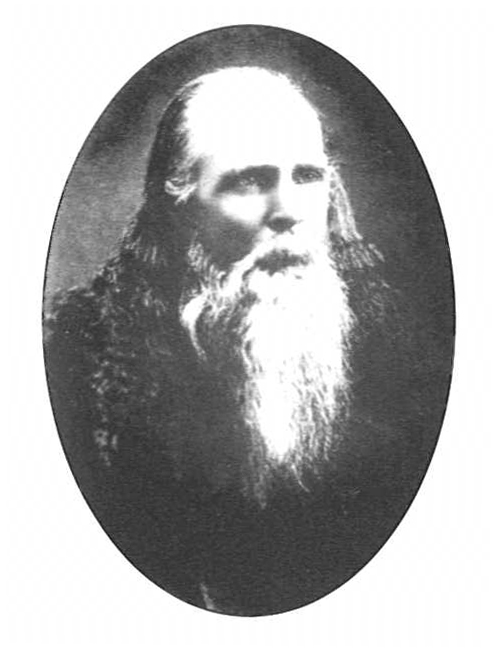 Orrin Porter Rockwell
Orrin Porter Rockwell
Civic and Business Enterprises
Several Latter-day Saints now played important roles in the economic and cultural development of San Francisco and Sacramento. The Brooklyn Saints were particularly enterprising and productive. The Robbins brothers purchased a horse off a boat from Sydney, Australia, and started the first express business in San Francisco. William Evans opened the first tailor shop on the West Coast on the corner of Market Street and Van Ness Avenue in San Francisco. Carolyn Joyce, known as the “Mormon Nightingale,” accompanied her songs with the first melodeon in the city. [21]
But Samuel Brannan, dabbling in a dozen or more enterprises, was the most famous and successful. In order to stock his gold-country stores, he began planning for a wharf in San Francisco to accommodate the largest sailing vessels. He was among the principal stockholders in the company that built the “long wharf.” It stretched nearly half a mile into the Bay at the very spot where he had first landed nearly three years before. [22] This was one of Brannan’s most visible enterprises. He frequently put capital at risk and encouraged others to join with him in improving the city.
He was among those who guided the transition of San Francisco from a forlorn outpost to a thriving metropolis which easily became the most important city on the West Coast for half a century. He was also actively developing the city of Sacramento and promoted a fellow Latter-day Saint, John Fowler, as mayor. Fowler had been with Brigham Young’s advance party of overland Pioneers who went to Utah. He had come to California with Brannan in 1847 to reunite with his wife, Jerusha, a Brooklyn passenger. Brannan and Fowler, using surplus lumber from one of Sutter’s mills, erected an elegant $100,000 hotel on the Sacramento waterfront. In September, they staged a gala grand-opening. The hotel was an instant success, netting them about thirty thousand dollars per year.
Brannan also built a fine home in San Francisco where he entertained eminent dignitaries. Located on the southeast corner of Washington and Stockton Streets, it looked out over the town below. It quickly became a popular meeting place for such elite figures as Commodore Stockton, Governor Mason, and the mayor of Sonoma, ex-Missouri governor Lilburn Boggs.
Brannan also became embroiled in a cause that eventually contributed to his loss of standing in the Church: the movement that became the San Francisco Vigilance Committee. The gold rush had attracted some unsavory characters, and San Francisco was now plagued by a particularly tough and lawless gang of ex-soldiers called the “Hounds” or “Regulators,” whom a contemporary described as “virtually a gang of public robbers.” The “town was paralyzed with terror” because of them. [23] Their modus operandi was to set large fires, and then, while the citizens were occupied as volunteer firemen, loot and pillage the citizens’ homes. Having no regular police force, Mayor T. M. Leavenworth was powerless to stop their thievery. The gang’s activities climaxed on Sunday evening, 15 July, with an attack in which several people were injured, robbed, or beaten. This attack “finally roused the community from its lethargy.” [24] The next day Brannan joined other citizens in urging Leavenworth to immediately help the community organize to defend itself. In response, Leavenworth directed all citizens to meet that afternoon in the plaza. Standing on the roof of the mayor’s office, Brannan addressed the crowd “and denounced in forcible terms the depredations and many crimes of the ‘hounds.’” He suggested that a collection be taken up for the relief of the victims of the previous night’s riot. Two hundred thirty men were soon enlisted as “special constables.” Each was given a musket and told to patrol in groups. After ten days’ duty, the men formed the nucleus of a permanent militia that policed the city as it thought appropriate. The group’s activities curbed the lawlessness that summer and fall; however, on Christmas Eve another mysterious fire broke out. Nearly half the city went up in smoke. Brannan’s new home escaped only because the wind shifted at the last minute. This narrow escape motivated him to fashion bolder, more extreme measures the following year.
Charles C. Rich’s Journey to California
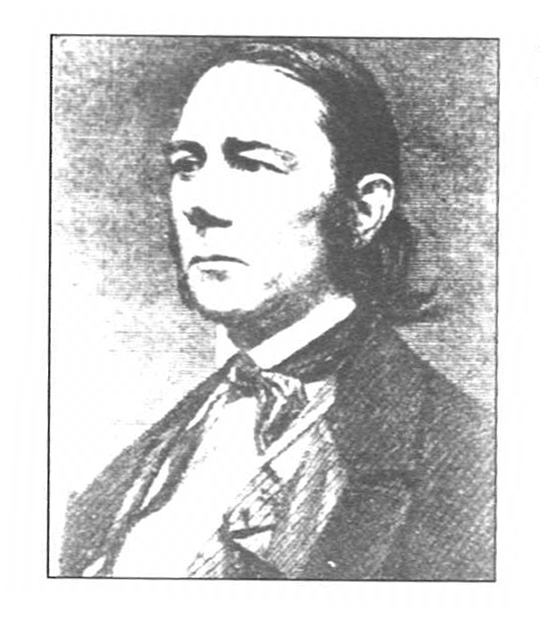 Charles C. Rich
Charles C. Rich
The postponement of Elder Rich’s journey to California did not result in a safe, uneventful passage. Of all the groups of Saints that traveled the route between the Great Basin and California, Elder Rich’s group probably suffered the most difficulty. The group was comprised mostly of non-Latter-day Saints. They interviewed Jefferson Hunt and hired him to lead their hundred-wagon train for ten dollars per wagon. [25] This was his third trip to California in three years, and although he had been over the route on horseback, he had never taken any wagons. However, in his estimation the journey could be made successfully if they followed the trail he knew. Addison Pratt, who had been called to return as a missionary to Polynesia, and his companion, gold-strike miner and former Battalion private James S. Brown, also joined this train.
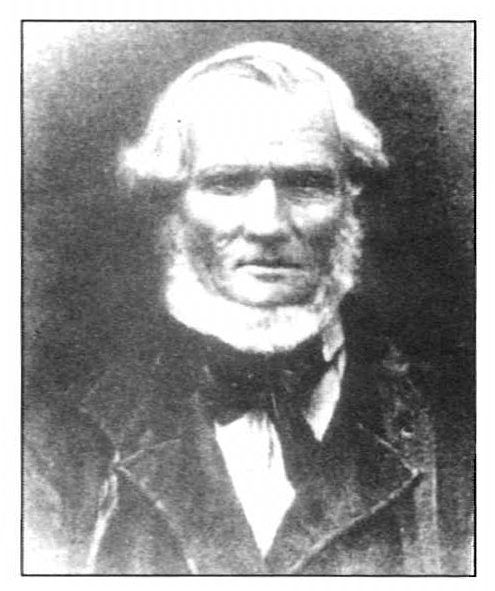 Jefferson Hunt
Jefferson Hunt
This was just one of several large trains Brigham Young authorized to go to California that fall as the Salt Lake Valley experienced its own small gold rush. Along with those anxious to go, some young men, including George Q. Cannon and former Battalion member Henry W. Bigler, responded to calls as missionaries to mine gold. [26] The Rich-Hunt train left Utah Valley via the southern route on 2 October. It included many Missourians and Illinoisans who did not trust a Latter-day Saint leader. When Hunt organized them in military fashion and demanded discipline, including rotating the lead wagon, they rebelled. As the trail grew hotter and more difficult, they became more irritable and aggressive. Some even threatened his life.
After three weeks they were overtaken by James Flake’s train of about twenty gold missionaries and a mounted party headed by a man named O. K. Smith, [27] who had a map showing a shorter route. Smith, usurping Hunt’s authority, offered to lead the train himself. For the next several days the large group debated the merits of Smith’s cutoff through Walker’s Pass. This alternate route to the gold fields was several hundred miles shorter than the route through Los Angeles. The gold missionaries, riding on horseback and hoping to get to the gold mines before the rainy season, decided to go with Smith through the cutoff.
They urged Elder Rich to leave the wagon train and join them. “He was impressed with the idea,” wrote George Q. Cannon, “that if he did not do so, some of us, if not all, would perish.” [28] On 29 October, a split occurred when the “packers” (on horseback) left the wagons behind and three days later reached the point where the cutoff left the Old Spanish Trail.
The wagons, traveling more slowly, reached the same point four days later. That evening the group had to decide whether to take the cutoff. Most were in favor but wanted to hear Hunt’s opinion. He acknowledged that he personally did not have any factual information about the proposed route but felt that it was unsafe. Exasperated, he continued, “You all know I was hired to go by way of Los Angeles, but if you all wish to go and follow Smith I will go also. But if even one wagon decides to go the original route, I shall feel bound to go with that wagon.” [29] The following morning “team after team turned to the right while now and then one would keep straight ahead as was at first intended. Capt. Hunt came over to the larger party after the division was made, and wished them all a hearty farewell and a pleasant happy journey.” [30]
Hunt secretly hoped that those who had threatened his life would choose Smith’s cutoff. An excerpt from the journal of Addison Pratt, who stayed with Hunt and shared his concerns, recalls:
As we began to give each other the parting hand, Br. Hunt put on a verry long face as if he was about to shed tears. I could not but smile at his sad looks. . . . I laughed at him a little about his crocodile tears. “Ah,” said he, “It was a policy for me to affect something before them for many of them have treated me very kindly and would to God! that I could get them out of the trouble they are now going into. They cannot get through with their waggons that way and I hardly think Br. Rich with the horsemen can, but they stand by far the best chance, but I told Br. Rich, if he found mountains that they could not pass, to be sure and slide back onto this trail, quick as possible and come on and overtake us. This,” continued he, “is one of the happiest days of my life. I cannot recollect the time when I have made so lucky escape from death as I have in getting rid of that company.” [31]
As Hunt predicted, Smith’s caravan, including Elder Rich and the gold missionaries, soon ran into trouble with almost impassable terrain. Several days of excessive heat without water brought excruciating thirst. Bigler recorded:
An emigrant of Captain Smith’s company came into our camp and said he would pay any price for a drink of water, there was none for sale. The day had been hot and my canteen was dry having drank and divided it with others. I said to this man that I was so dry myself that if I had a drink, I would not take fifty dollars for it. Brother Rich, who was sitting by, said to me, “have you no water”? I replied, no sir, in a few minutes afterwards he called to me, it was away from the fire in the dark. I went, he handed me his canteen and said, “Drink, drink, you are welcome.” The canteen seemed to be two-thirds full. I said, no Brother Rich, but he urged me to drink, saying, he had not been very thirsty himself that day and I was welcome to a drink. I said to myself, God bless the man. [32]
The next day the struggling group descended into a canyon, where, after several hours, they discovered a small spring. “Pure, sparkling, cold water was there,” Cannon recalled, “gurgling as it ran over the rocks in the channel. Oh, what music to our ears was in the sound! How ravishing the sight! It was not a large stream; but it was sufficient; and a body of water as large as Lake Superior could not have produced more joy or thankfulness.” [33]
After four more days without enough water, it began to rain. Soon the water was coming down in torrents. “I rode on horseback,” described Cannon, “and I turned up the rim of my hat, and made it something like a dish. By carrying my head very steady I contrived to catch some rain, to which the hat gave a smoky flavor; but it quenched thirst. . . . I have always believed that this shower of rain was sent to save our lives.” [34] O. K. Smith also acknowledged that “it was plain to him that the finger of the Lord was in the rain.” [35]
The Smith group found the trail increasingly difficult. Elder Rich urged them to follow Hunt’s advice and return to the original trail. “We were relieved by his remarks,” Cannon confessed. “They made us feel glad; for we knew that he, not Captain Smith, had the right to lead us, and that if we should be saved from our perilous circumstances, it would be through him. It seemed as though the Lord had permitted us to wander . . . to arouse every one to a sense of the peril we were in, that he whose right it was to lead us might be justified in the eyes of all in dictating our future movements.” [36]
Elder Rich and the gold missionaries did turn back and intercepted Hunt on 18 November. Smith, stubbornly holding to his original plan, swore, “If you do not hear from me, you may know that I died with my face westward.” After only a day and a half’s further travel, however, he, too, returned to the original trail. “By this time Smith had either forgotten his oath, or thought dying with his face westward was not so pleasant as he had imagined it would be.” [37] Nearly eighty of the wagons likewise turned back and rejoined the main trail.
The twenty-seven remaining wagons, including a group of young, single men known as the “Jolly Jayhawkers,” and some avowed Mormon-haters, including Reverend J. W. Brier, who had influenced many to leave Hunt, kept to the “shortcut.” Only a few of these dissenters lived to tell their tale. They eventually discarded their wagons and belongings and attempted to cross, on foot, California’s Death Valley, which they named. [38] The dry desert heat claimed most of their lives.
In contrast, the wagons that traveled the established trail with Captain Hunt arrived in Southern California without further incident. Once again, the gold missionaries, on horseback, went ahead of Hunt’s wagon train. At the Mojave River, they met an emigrant family which had been stranded there a month and had subsisted only on beef. Although the Latterday Saints were also running low on provisions, they gave the family sufficient flour to survive. “It was a pitiable sight to see them in their condition,” Bigler wrote. “The poor little children, my heart was filled for them.” [39] The family was among the first of thousands who traveled to California with too little. Elder Rich and the mounted group of gold missionaries reached Isaac Williams’s ranch on 10 December, with Hunt and the slower-moving wagons arriving twelve days later. Elder Rich, having survived the trip, was safely in California, where his presence would influence events for nearly a decade.
Notes
[1] J. S. Holliday, The World Rushed In: The California Gold Rush Experience (New York: Simon and Schuster, 1981), 297.
[2] Preston Nibley, Brigham Young: The Man and His Work (Salt Lake City: Deseret Book, 1970), 128.
[3] Ibid., 128–29.
[4] Orson F. Whitney, Life of Heber C. Kimball (Salt Lake City: Bookcraft, 1975), 391.
[5] James Holbrook, quoted in Leonard J. Arlington, Great Basin Kingdom: An Economic History of the Latter-day Saints, 1830–1900 (Cambridge, Mass.: Harvard University Press, 1958), 71.
[6] Neal A. Maxwell, “President James E. Faust: ‘Pure Gold,’” Ensign, August 1995,14.
[7] Journal History, 26 and 31 March 1849 (hereafter JH); LDS Church Archives.
[8] Ibid., 12 February, 31 March, 8 and 12 April 1849.
[9] Quoted in J. Kenneth Davies, Mormon Cold: The Story of California’s Mormon Argonauts (Salt Lake City: Olympus, 1984), 159.
[10] JH, 5 April 1849.
[11] Eugene E. Campbell, “A History of The Church of Jesus Christ of Latter-day Saints in California, 1846–1946” (Ph.D. diss., University of Southern California, 1952), 135–38; Davies, 113–14.
[12] Davies, 110–11.
[13] Millennial Star 12, no. 14 (15 July 1850): 214–15.
[14] Davies, 86.
[15] Albert R. Lyman, Amasa Mason Lyman: Trailblazcr and Pioneer from the Atlantic lo the Pacific (Delta, Utah: Melvin A. Lyman, 1957), 201.
[16] Ibid.
[17] Davies, 156.
[18] Harold Schindler, Orrin Porter Rockwell: Man of God, Son of Thunder (Salt Lake City: University of Utah Press, 1983), 186.
[19] Richard Lloyd Dewey, Porter Rockwell: A Biography (New York: Paramount Books, 1987), 155.
[20] Ibid.
[21] Amelia D. Everett, “Hie Ship Brooklyn,” California Historical Society Quarterly 37 (1958): 236–37.
[22] Zoeth Skinner Eldredge, The Beginnings of San Francisco from the Expedition of Anza, 1774 to the City Charier of April 15,1850 (San Francisco: Zoeth S. Eldredge, 1912), 2:573–74; Reva Scott, Samuel Brannan and the Golden Fleece (New York: Macmillan, 1944), 240–41.
[23] Frank Soule, John H. Gihon, and James Nisbet, The Annals of San Francisco (New York: D. Appleton, 1855), 227.
[24] Roger W. Lotchin, San Francisco 1846–1856: From Hamlet to City (Lincoln, Nebr.: University of Nebraska Press, 1974), 191.
[25] William Lewis Manly, Death Valley in ‘49 in March of America Facsimile Series, no. 90 (Ann Arbor, Mich.: University Microfilms), 105.
[26] See Henry Bigler, “Journal Extracts of Henry Bigler,” Utah Historical Quarterly 5, no. 3 (July 1932): 101; George Q. Cannon, “Twenty Years Ago: A Trip to California,” Juvenile Instructor, January–June 1869; 16 January 1869, 13.
[27] Possibly Brooklyn passenger Orin K. Smith
[28] Cannon, 13 February 1869, 28.
[29] Manly, 110.
[30] Ibid., 111.
[31] Quoted in Pauline Udall Smith, Captain Jefferson Hunt of the Mormon Battalion (Salt Lake City: The Nicholas G. Morgan Sr. Foundation, 1958), 154.
[32] Bigler, 107–8.
[33] Cannon, 10 April 1869, 60.
[34] Ibid., 24 April 1869,68.
[35] Bigler, 109.
[36] Cannon, 10 April 1869, 60.
[37] Ibid., 8 May 1869, 78–79.
[38] Quoted in Erwin Gudde, California Place Names (Berkeley and Los Angeles: University of California Press, 1969), 85–86.
[39] Bigler, 112.
